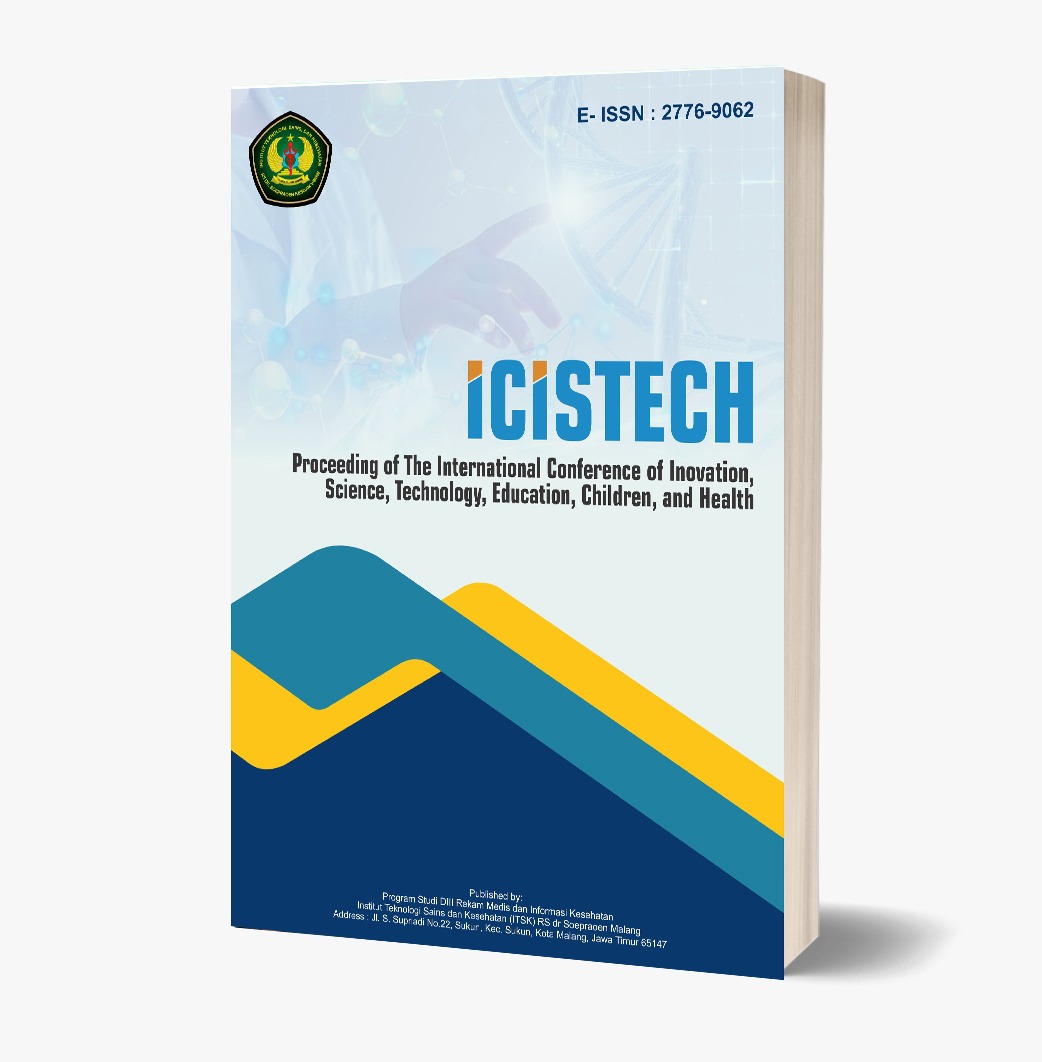Determination of Stunting Handling Policy on Enggano Island as One of The Outer Islands
DOI:
https://doi.org/10.62951/icistech.v4i2.72Keywords:
Health Policy, Local Wisdom, Remote Island, Stunting, System DynamicsAbstract
This research focuses on the implementation of stunting prevention policies in Enggano Island, North Bengkulu Regency, with special attention to policy determinants in remote areas. To understand the complexity and dynamics of interactions between factors that influence the success of health policies in this hard-to-reach area, this research uses a qualitative explanatory approach with case study methods and dynamic system modeling. The results show that the success in reducing stunting rates on Enggano Island cannot be separated from the active involvement of various parties, including the government, health workers, and community leaders, who all work together in monitoring, educating, and providing additional food to children at risk of stunting. In addition, utilizing local wisdom has been shown to play an important role in strengthening households' adaptive capacity to this health problem, which in turn contributes to reducing stunting rates. Policy support complemented by good management also allows for more effective collaboration between actors, thus facilitating policy implementation. This research provides new insights into the importance of integrating local values and cross-sectoral cooperation in addressing health challenges in remote areas. The findings also emphasize that a holistic and adaptive policy approach is necessary for successful stunting management, especially in areas with limited access and resources.
References
Adi, S., Krisnana, I., Rahmawati, P. D., & Maghfiroh, U. (2023). Environmental factors that affect the incidence of stunting in under-five children: A literature review. Pediomaternal Nurs. J., 9(1). https://doi.org/10.20473/pmnj.v9i1.43863
Akseer, N., Kandru, G., Keats, E. C., & Bhutta, Z. A. (2020). COVID-19 pandemic and mitigation strategies: Implications for maternal and child health and nutrition. Am. J. Clin. Nutr., 112(2), 251–256. https://doi.org/10.1093/ajcn/nqaa171
Anggraeny, B., Firmansyah, M., Helmi, A., & Ramdhani, N. Z. (2024). Policy brief: Pertanian, kelautan, dan biosains tropika.
Atamou, L., Rahmadiyah, D. C., Hassan, H., & Setiawan, A. (2023). Analysis of the determinants of stunting among children aged below five years in stunting locus villages in Indonesia. Healthc., 11(6). https://doi.org/10.3390/healthcare11060810
Badan Pusat Statistik. (2022). Laporan indeks khusus penanganan stunting 2021-2022. BPS Indonesia. Retrieved from https://www.bps.go.id/id
Beal, T., Tumilowicz, A., Sutrisna, A., Izwardy, D., & Neufeld, L. M. (2018). A review of child stunting determinants in Indonesia. Maternal and Child Nutrition, 14(4). https://doi.org/10.1111/mcn.12617
Browne, J., et al. (2021). Systems thinking for Aboriginal Health: Understanding the value and acceptability of group model building approaches. SSM - Popul. Heal., 15, 100874. https://doi.org/10.1016/j.ssmph.2021.100874
Cameron, L., Chase, C., Haque, S., Joseph, G., Pinto, R., & Wang, Q. (2021). Childhood stunting and cognitive effects of water and sanitation in Indonesia. Econ. Hum. Biol., 40. https://doi.org/10.1016/j.ehb.2020.100944
Carletto, C., Maluccio, J. A., Shrestha, S. M., & Stewart, M. F. (2021). Migration, economic crisis and child growth in rural Guatemala: Insights from the Great Recession. Food Policy, 104(August), 102145. https://doi.org/10.1016/j.foodpol.2021.102145
Colebatch, H. K. (2006). Thinking about policy: finding the best way. Policy, (May).
Emerson, K., Nabatchi, T., & Balogh, S. (2012). An integrative framework for collaborative governance. J. Public Adm. Res. Theory, 22(1), 1–29. https://doi.org/10.1093/jopart/mur011
Fan, S., Teng, P., Chew, P., Smith, G., & Copeland, L. (2021). Food system resilience and COVID-19 – Lessons from the Asian experience. Glob. Food Sec., 28, 100501. https://doi.org/10.1016/j.gfs.2021.100501
Gani, A. A., Hadju, V., Syahruddin, A. N., Otuluwa, A. S., Palutturi, S., & Thaha, A. R. (2021). The effect of convergent action on reducing stunting prevalence in under-five children in Banggai District, Central Sulawesi, Indonesia. Gac. Sanit., 35, S421–S424. https://doi.org/10.1016/j.gaceta.2021.10.066
Harding, K. L., Aguayo, V. M., & Webb, P. (2018). Factors associated with wasting among children under five years old in South Asia: Implications for action. PLoS One, 13(7). https://doi.org/10.1371/journal.pone.0198749
Hurley, K. M., et al. (2021). A longitudinal impact evaluation of a comprehensive nutrition program for reducing stunting among children aged 6-23 months in rural Malawi. Am. J. Clin. Nutr., 114(1), 248–256. https://doi.org/10.1093/ajcn/nqab010
Ihsani, N. A., Setiani, O., Masyarakat, K., & Diponegoro, U. (2022). Studi literatur: Pengaruh faktor kesehatan lingkungan terhadap kejadian stunting pada balita di Indonesia. J. Ris. Kesehat. Poltekkes Depkes Bandung, 14(2).
Kementerian Kesehatan RI. (2021). Buku saku: Hasil studi status gizi Indonesia (SSGI) tingkat nasional, provinsi, dan kabupaten/kota tahun 2021. Kemenkes. Retrieved from https://layanandata.kemkes.go.id/katalog-data/ssgi/ketersediaan-data/ssgi-2022
Kementerian Kesehatan RI. (2022). Buku saku hasil survei status gizi Indonesia (SSGI) tahun 2022.
Kementerian Koordinator Bidang Pembangunan Manusia dan Kebudayaan RI. (2024). Pemerintah optimis target penurunan stunting 14 persen tercapai di 2024. Menko PMK. Retrieved from https://www.kemenkopmk.go.id/pemerintah-optimis-target-penurunan-stunting-14-persen-tercapai-di-2024
Kementerian Sekretariat Negara. Dashboard pemantauan terpadu percepatan pencegahan stunting. Retrieved from https://dashboard.stunting.go.id/
Latuszynska, M., & Fate, S. (2022). Combining system dynamics and agent-based simulation to study the effects of public interventions on poverty. Procedia Comput. Sci., 207, 3978–3987. https://doi.org/10.1016/j.procs.2022.09.460
Madzorera, I., et al. (2021). Food systems as drivers of optimal nutrition and health: Complexities and opportunities for research and implementation. Curr. Dev. Nutr., 5, nzab062. https://doi.org/10.1093/cdn/nzab062
Peraturan Presiden Nomor 72 Tahun 2021 tentang Percepatan Penurunan Stunting.
Presiden Republik Indonesia. (2020). Peraturan Presiden Republik Indonesia Nomor 18 Tahun 2020 Tentang Rencana Pembangunan Jangka Menengah Nasional 2020-2024, 1–7.
Purwanti, R., & Nurfita, D. (2019). Review literatur: Analisis determinan sosio demografi kejadian stunting pada balita di berbagai negara berkembang. Bul. Penelit. Kesehat., 47(3), 153–164. https://doi.org/10.22435/bpk.v47i3.1349
Purwestri, R. C., Renz, L., Wirawan, N. N., Jati, I. R. A. P., Fahmi, I., & Biesalski, H. K. (2017). Is agriculture connected with stunting in Indonesian children living in a rice surplus area? A case study in Demak regency, central Java. Food Secur., 9(1). https://doi.org/10.1007/s12571-016-0634-2
Ramdhani, N. Z., Anggraeny, B., Firmansyah, M., & Helmi, A. (2024). Policy brief: Pertanian, kelautan, dan biosains tropika.
Sekretariat Kabinet Republik Indonesia. (2023). Targetkan prevalensi 14 persen di 2024, presiden dorong kerja bersama untuk penurunan stunting. Setkab. Retrieved from https://setkab.go.id/targetkan-prevalensi-14-persen-di-2024-presiden-dorong-kerja-bersama-untuk-penurunan-stunting
Tigchelaar, M., et al. (2022). The vital roles of blue foods in the global food system. Glob. Food Sec., 33(March), 100637. https://doi.org/10.1016/j.gfs.2022.100637
Torlesse, H., Cronin, A. A., Sebayang, S. K., & Nandy, R. (2016). Determinants of stunting in Indonesian children: Evidence from a cross-sectional survey indicate a prominent role
Downloads
Published
How to Cite
Issue
Section
License
Copyright (c) 2024 Proceeding of The International Conference of Inovation, Science, Technology, Education, Children, and Health

This work is licensed under a Creative Commons Attribution-ShareAlike 4.0 International License.













